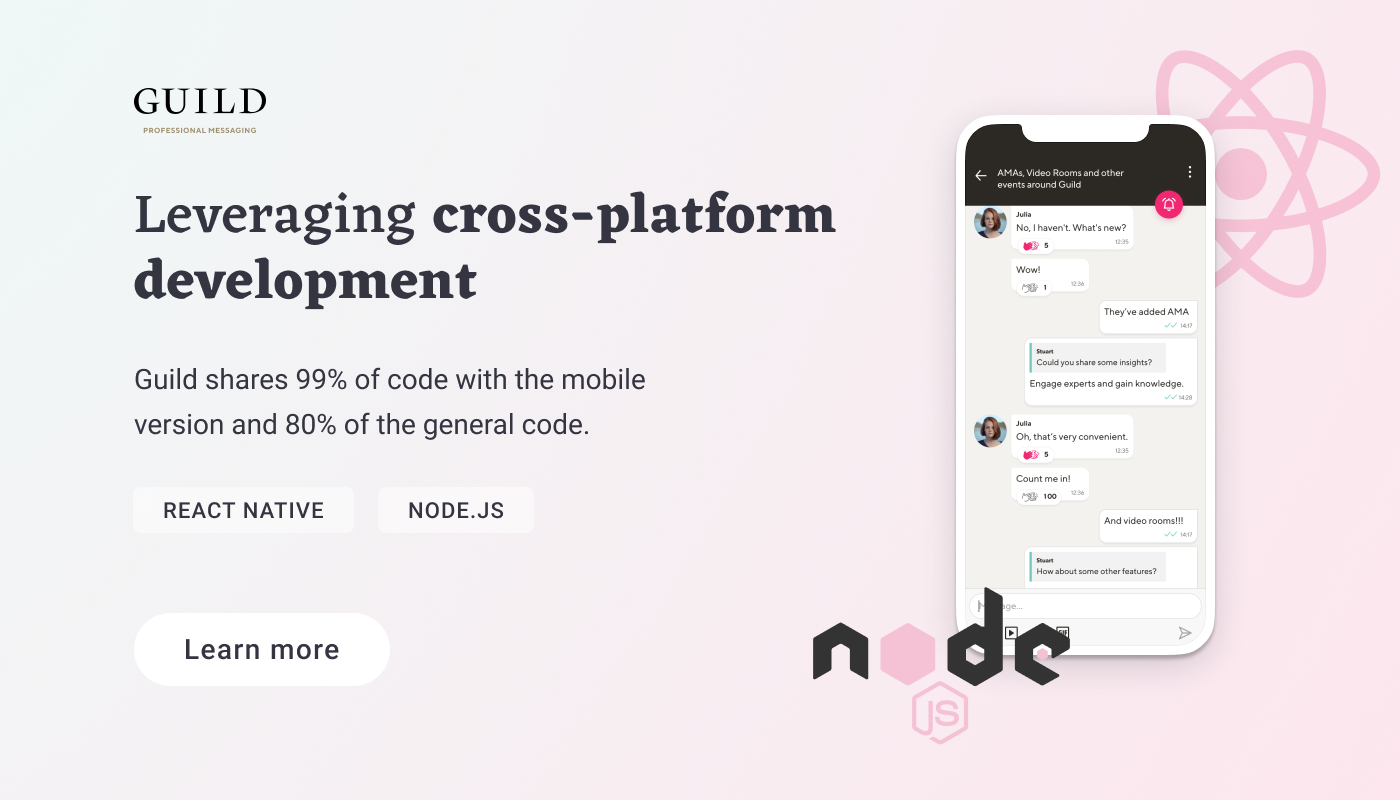The State of Vue.js Report 2025 is now available! Case studies, key trends and community insights.
Table of Contents
Node.js is still on track to take over the open source community. Big players from multiple enterprise-level organizations are either implementing it or considering this programming language for their next platform. LinkedIn, Mozilla, Netflix, the list goes on. They've all bet on Node due to its scalability, performance, and twice-yearly releases (including one annual long-term service release). But there are many more reasons why enterprises choose Node.js.
As a software development company with Node.js in our tech stack, we have discussed Node's benefits dozens of times with our clients. And now I'm sharing those insights with you.

Its growing popularity does not necessarily mean that everyone should consider going with Node for their application right now. After all, it shouldn’t matter how popular a technology is or whether one name seems more familiar than the other —what should matter is making educated decisions about your technology stack.
And in this post, we’ll be outlining how we make these sorts of decisions here at Monterail.
For years, we’ve been recognized for our Ruby on Rails expertise and now, from today’s perspective, the label feels a bit odd. In the end, many front-end devs try to avoid such narrow specialization and aim to become full-stack developers. And it’s easier to achieve that in an efficient, Javascript-favorable ecosystem used in both front- and backend development. Hence, a huge part of our Web development revolves around JavaScript frameworks—Vue.js, AngularJS, React for front-, and Node.js for backend.
Although Ruby on Rails is our mother tongue, it doesn’t mean we can’t speak other programming languages as well. But what did actually bring us closer to Node.js?
For the last couple of years, we stuck by RoR for a number of reasons:
- high market demand,
- it works great for MVPs due to the fast pace of development,
- it is easy and efficient for developers to move between different Rails projects,
- it teaches developers good coding habits,
- Ruby code is very readable and mostly self-documenting,
- it’s a well-proven, full-fledged technology
Rails is obviously not going to fade away. It’s a stable, mature technology that has a lot to offer to businesses. But it’s still just a tool that needs skilled craftsmen. Combining even an imperfect tool with perfectly skilled programmers will make a great application. After all, your users won’t care what’s under the hood, only if their application is useful and intuitive and loads fast.
Yet, the whole Web seems to be turning to JavaScript.

Most popular languages for developers. Source: Stack Overflow 2022 Survey
Node.js From a Developer’s Perspective
Node.js has been there for a while, but began gaining real traction only in 2011 when LinkedIn launched its mobile app. Node.js is one of the most popular kid on the block—in 2017, 98% of Fortune 500 companies use Node.js in their applications regularly. It also wins as the most used web framework.
As a technology company, it’s paramount we stay up to date with all tech news and trends. We seem to be nearing peak demand for Node, so it was high time for us to find out what all the fuss was about. Additionally, more and more clients were approaching us asking about Node, but we decided that we would ultimately add it to our tech stack only after getting approval from our programmers.
After some research and feedback from the team, we recognized that Node.js could be a viable alternative for our backend development:
- we were already quite comfortable with the Javascript ecosystem—developers already knew the language so shifting to a similar open-source framework, with the official implementation and documentation in JavaScript seemed feasible,
- using the same language on the server side and the client side is a key advantage that enhances internal communication and understanding of the product as a whole,
- Node.js provides a non-blocking IO system that lets you process numerous requests concurrently,
- Node.js has a great number of unpolarized libraries enabling considerable software development freedom,
- our team was really fired up by Typescript which provides the tooling that Ruby lacks—although Typescript is opinionated especially at the beginning, it helps a lot later down the line, making testing faster and much smoother,
- Typescript also helps detect errors faster than in other frameworks and organizes the code in such a way that developers can dive into the project easily and quickly,
- further maintenance of your project will require only a small dev team,
- it’s been verified by the market—there are more and more apps out there based on Node. We have been receiving a bunch of inquiries for projects in this technology, too.
Hence, stemming from real business needs, the decision to incorporate Node.js into our backend stack was not exactly a game changer, but rather a natural next step in our growth.
We’ve already worked on a few Node.js-based projects, including Guild—a private messaging app for professionals, and multiple apps for one of our enterprise-level client. Detailed case studies with know-how and lessons learned are on the way, so stay tuned.

So, Is Node.js the Solution You Need in Your Product?
Although Node.js has many valuable virtues and works well for these clients—it might not be the best choice for every project. Node.js should be considered for any real-time applications intended to run on various devices. If your product requires fast prototyping or performs CPU-intensive tasks (like generating graphics) there are other technologies, including Rails, that will do a better job. By choosing Node for heavy computation tasks, you will actually lose most of the advantages it offers. Use it in scalable, fast network apps with many users, however, and Node will shine.
Where does Node.js fall short? In terms of out-of-the-box solutions. Contrary to RoR, many things need to be done from scratch, which in turn increases the project’s overall duration. On the other hand, however, if you’re next app is meant to have a long lifespan, the time and costs invested in the beginning offer considerable returns in the long run—you gain a number of tools that will streamline the addition of features in the future. Doing this with out-of-the-box solutions might be more troublesome. Therefore, Node.js is perfect for custom-tailored, fast and scalable software.
All in all, it’s not bad news.
When and why should you consider Rails in building your next project? Rails is mostly recommended for small projects, MVPs, and product validation, but it doesn’t necessarily mean you have to follow that pattern. You might opt for what Twitter did: launch on Rails and move to a new platform once you start making money and need to scale. You can also stick to Rails like Airbnb did and do just fine.
At the end of the day, it is not about the tool, but about who uses it, and why.

:quality(90))
:quality(90))